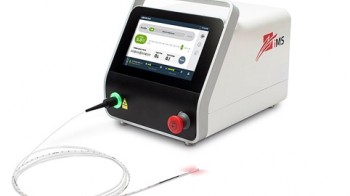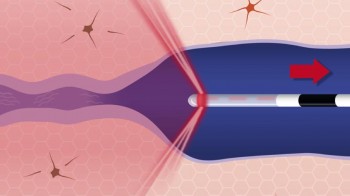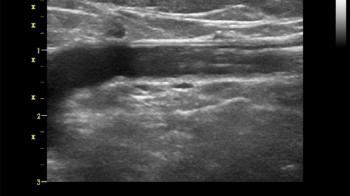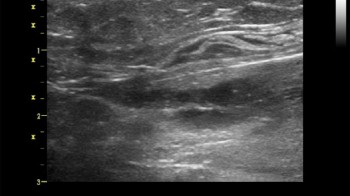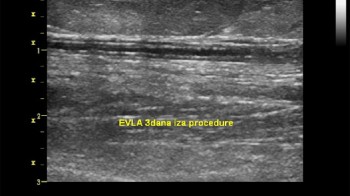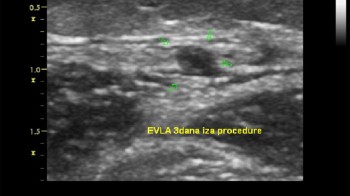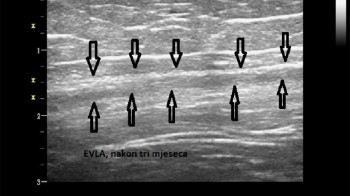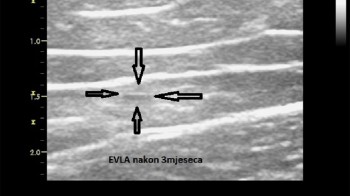EVLT(Endovenous Laser Therapy)
The endovenous use of lasers began in 2001, first with wavelengths of 810, 940, and 980 nm, which are most strongly absorbed by hemoglobin. Starting in 2009, a 1470 nm laser began to be used, which is best absorbed in water and has proven to be superior to other laser technologies, especially when combined with radial fibers, in terms of reduced pain, fewer complications, and easier post-procedural recovery.
In 2019, a 5th generation laser with a wavelength of 1940 nm emerged, setting a new standard in endovenous laser ablation, of which the simLA 6 is one of the best. The treatment has become faster, taking 15-20 minutes per leg, with minimal or no local anesthesia required, a short duration of compression stockings for 2-5 days, and a quicker recovery.
Its main advantages are the high absorption of laser light in water, lower working temperatures, avoiding penetration into surrounding tissue, reduced tissue damage, decreased hyperpigmentation and recovery time, increased patient comfort during the procedure, minimal or no pain during and after the procedure, and shortened procedures due to the use of minimal local anesthesia.
This device also utilizes new AntiStick® laser fibers, which are extremely precise, with a diameter of only 1.0 mm. The AntiStick® laser fiber is the finest and most flexible on the market for endovenous therapy. The unique radial pattern of the laser beam leads to a reduced tendency to stick during the procedure, and it allows for treatment of shorter and shallower segments of veins than ever before.
Optimized FOCUS for Higher Quality
Precision is a crucial part of dedicated quality treatment. Due to its technique, simLa® 6 focuses heat only on the inner side of the vein without affecting surrounding tissues. As a result, less energy and lower maximum temperatures are required for reliable closure without compromising long-term results.
Less ENERGY – Excellent Results
Thanks to the wavelength of 1940 nm, the simLa® 6 operates very efficiently with power ranging from 2W to a maximum of 6 Watts. Nonetheless, with very good long-term results, it meets the high expectations of both professionals and patients. Studies have shown that LEED of 35 J/cm – 40 J/cm is sufficient, while older generation lasers require more than 80 J/cm or more.
Reduced RISK of Negative Side Effects
By focusing heat only on the inner side of the vein, negative side effects such as temporary nerve damage, discoloration, postoperative pain, and prolonged recovery time have been significantly reduced or even avoided altogether.
More COMFORT for a Better Life
Due to its advantages over older generation lasers, simLa® 6 is further focused on patient comfort, and it is currently the most advanced endovenous thermal treatment for varicose veins used by vascular surgeons, phlebologists, and dermatologists. It allows for a shorter duration of using compression stockings after the procedure than any other technology.
Wavelength Makes a Difference
A laser is defined by its wavelength. Each wavelength has a very specific effect on certain cells or molecules, leading to very specific effects in terms of cutting, closing, activating, or healing something. Generating wavelengths can be very complicated and complex, such as wavelengths below 800 nm or above 1900 nm. The efforts of specific wavelengths come with various other complications, such as enormous costs for such machines, significant weight, or simple difficulties in introducing that wavelength into the human body.
Innovation at 1940 nm
Technically speaking, the laser is not a source of heat like radiofrequency (RF) technology. Instead, the laser light, in this case, excites water molecules and activates them, generating heat. Therefore, laser technology can be used for more precise and specific treatments. For a long time, the generation of 1940 nm was not feasible at a reasonable cost-to-effectiveness ratio. This is especially necessary in applications such as treating varicose veins and similar conditions. Due to the large number of potential patients, demand is high, but it requires treatment at an acceptable price. iMS has found a way to generate this specific laser wavelength of 1940 nm at an acceptable cost. The simLa 6 laser was the first diode laser of this wavelength in the world.
New endovenous methods using only local anesthesia or utilizing 1940 nm wavelength technology without any anesthesia have become predominant over surgical methods.
We use the most advanced laser technology with a wavelength of 1940 nm, which is best absorbed in water and most effectively induces changes in the walls of the treated vein, with the least side effects. Additionally, we only use radial laser fibers, which allow for the most precise application of laser energy, much better than the 980 nm laser technology and bare or spherical laser fibers. EVLT (Endovenous Laser Treatment) is a minimally invasive procedure performed under ultrasound guidance and with the administration of the so-called tumescent local anesthesia or with a femoral nerve block. The procedure itself lasts about 30 minutes, and the patient typically resumes regular activities just 1 or 2 days afterwards.
RFA - EVRF (Endovenous Radiofrequency Treatment)
The radiofrequency endovenous treatment is based on closing affected (enlarged) veins from the inside using microwaves. Advantages of radiofrequency treatment:
- The treatment is very effective.
- It can be done year-round and is especially recommended during the summer months.
- There are no significant side effects.
- The patient does not necessarily have to wear compression stockings after the procedure, or they may only need to be worn for 48-72 hours.
- It is used for the treatment of large veins, as well as for rosacea, petechiae, spider nevi, and telangiectasia.
Miniflebectomies
Ambulatory miniflebectomy is a method of removing larger clusters of varicose veins. It is performed under local anesthesia, also in an office setting under outpatient conditions. The veins are removed through micro-incisions in the skin measuring 1-2 mm.
Minisclerotherapy, laser, and RF treatment of capillaries
These methods are used for the treatment of spider veins and enlarged capillaries visible on the surface of the skin. Thin needles are used to inject sclerosants, thin needles for RFA, or laser beams that cause the veins to disappear, along with the use of Veinlite, which provides better visibility of veins and capillaries. The treatment is repeated as needed at intervals of 4-8 weeks.
Further information can be found on the following pages:

